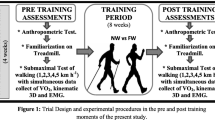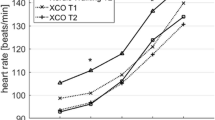Abstract
Introduction
Walking is a popular exercise but does not increase lower limb muscle strength and balance. We hypothesized that muscle strength, physical and cognitive function would be improved by inserting lunges in conventional walking.
Methods
Eleven regular walkers (54–88 years) who had more than 5000 steps in exercise walking a day at least 5 days a week participated in this study. They walked as usual for the first 4 weeks and included lunges and descending stairs or slope walking (i.e., eccentric walking) for the next 8 weeks. The steps of eccentric walking were gradually increased from 100 to 1000 steps per week over 8 weeks.
Results
The average steps per day were 10,535 ± 3516 in the first 4 weeks, and 10,118 ± 3199 in the eccentric walking period without a significant difference. No significant changes in maximal voluntary isometric contraction torque of the knee extensors (MVC), 30-s chair stand (CS), 2-min step, balance assessed by center of pressure movement area with eyes close, sit and reach, a digit symbol substitution test (DSST) for cognitive function were observed in the first 4 weeks. However, significant (P < 0.05) improvements were evident in MVC (18.6 ± 15.7%), CS (24.2 ± 17.3%), balance ( – 45.3 ± 34.5%), and DSST (20.8 ± 16.7%) from weeks 4 to 12. Serum complement component 1q concentration decreased (P < 0.05) from weeks 4 to 12, although no changes in serum glucose, triglyceride, and cholesterol concentrations were observed.
Conclusion
These results supported the hypothesis, and suggest that eccentric walking provides effects that are not achieved by conventional walking.




Similar content being viewed by others
Data availability
The raw data supporting the conclusions of this article will be made available by the authors, without undue reservation.
Abbreviations
- ADL:
-
Activities of daily living
- Bal-EC:
-
Static balance ability with eyes closed
- CS:
-
30‑s chair stand
- C1q:
-
Complement component 1q
- GLU:
-
Glucose
- HDLC:
-
High-density lipoprotein cholesterol
- LDLC:
-
Low-density lipoprotein cholesterol
- MT:
-
Muscle thickness
- MVC:
-
Maximal voluntary isometric contraction
- 2MS:
-
2‑min step test
- SR:
-
Sit‑and‑reach test
- TC:
-
Total cholesterol
- TG:
-
Triacylglycerols
- TUG:
-
3‑m timed up and go test
References
Abbott RD, White LR, Ross GW, Masaki KH, Curb JD, Petrovitch H (2004) Walking and dementia in physically capable elderly men. JAMA 292(12):1447–1453
Borg GA (1982) Psychophysical bases of perceived exertion. Med Sci Sports Exerc 14(5):377–381
Chang KW, Lin CM, Yen CW, Yang CC, Tanaka T, Guo LY (2021) The effect of walking backward on a treadmill on balance, speed of walking and cardiopulmonary fitness for patients with chronic stroke: a pilot study. Int J Environ Res Public Health 18(5):2376
Chen TC, Hsieh CC, Tseng KW, Ho CC, Nosaka K (2017a) Effects of descending stair walking on health and fitness of elderly obese women. Med Sci Sports Exerc 49(8):1614–1622
Chen TC, Tseng WC, Huang GL, Chen HL, Tseng KW, Nosaka K (2017b) Superior effects of eccentric to concentric knee extensor resistance training on physical fitness, insulin sensitivity and lipid profiles of elderly men. Front Physiol 8:209
Chen TC, Huang TH, Tseng WC, Tseng KW, Hsieh CC, Chen MY, Chou TY, Huang YC, Chen HL, Nosaka K (2021) Changes in plasma C1q, apelin and adropin concentrations in older adults after descending and ascending stair walking intervention. Sci Rep 11(1):17644
Ekstrom RA, Donatelli RA, Carp KC (2007) Electromyographic analysis of core trunk, hip, and thigh muscles during 9 rehabilitation exercises. J Orthop Sports Phys Ther 37(12):754–762
Fukusaki C, Masani K, Miyasaka M, Nakazawa K (2016) Acute positive effects of exercise on center-of-pressure fluctuations during quiet standing in middle-aged and elderly women. J Strength Cond Res 30(1):208–216
Garmany A, Yamada S, Terzic A (2021) Longevity leap: mind the healthspan gap. NPJ Regen Med 6(1):57
Gault ML and Willems ME (2013) Isometric strength and steadiness adaptations of the knee extensor muscles to level and downhill treadmill walking in older adults. Biogerontology 14(2):197–208
Ikezoe T, Mori N, Nakamura M, Ichihashi N (2011) Age-related muscle atrophy in the lower extremities and daily physical activity in elderly women. Arch Gerontol Geriatr 53(2):e153–157
Jaeger J (2018) Digit symbol substitution test: the case for sensitivity over specificity in neuropsychological testing. J Clin Psychopharmacol 38(5):513–519
Japan sports agency public opinion survey on the state of sports practice conducted (2023) https://www.mext.go.jp/sports/b_menu/houdou/jsa_00133.html
Kan B, Speelman C, Nosaka K (2019) Cognitive demand of eccentric versus concentric cycling and its effects on post-exercise attention and vigilance. Eur J Appl Physiol 119(7):1599–1610
Katsura Y, Takeda N, Hara T, Takahashi S, Nosaka K (2019) Comparison between eccentric and concentric resistance exercise training without equipment for changes in muscle strength and functional fitness of older adults. Eur J Appl Physiol 119(7):1581–1590
Kay AD, Baxter BA, Hill MW, Blazevich AJ (2023) Effects of eccentric resistance training on lower-limb passive joint range of motion: a systematic review and meta-analysis. Med Sci Sports Exerc 55(4):710–721
Langhammer B, Bergland A, Rydwik E (2018) The importance of physical activity exercise among older people. Biomed Res Int 2018:7856823
Lee J and Kim J (2022) Effects of an 8-week lunge exercise on an unstable support surface on lower-extremity muscle function and balance in middle-aged women. Phys Act Nutr 26(4):14–21
Lee LL, Mulvaney CA, Wong YKY, Chan ES, Watson MC, Lin HH (2021) Walking for hypertension. Cochrane Database Syst Rev 2(2):CD008823
López-de-Celis C, Labata-Lezaun N, Romaní-Sánchez S et al (2023) Effect of load distribution on trunk muscle activity with lunge exercises in amateur athletes: cross-sectional study. Healthcare (basel) 11(6):916
Ministry of health, labour and welfare, summary of results of the national health and nutrition examination survey in 2019 (2020) https://www.mhlw.go.jp/stf/seisakunitsuite/bunya/kenkou_iryou/kenkou/eiyou/r1-houkoku_00002.html
Morris JN, Hardman AE (1997) Walking to health. Sports Med 23(5):306–332 (published correction appears in Sports Med 1997 Aug; 24(2):96)
Muollo V, Rossi AP, Milanese C, Masciocchi E, Taylor M, Zamboni M, Rosa R, Schena F, Pellegrini B (2019) The effects of exercise and diet program in overweight people - nordic walking versus walking. Clin Interv Aging 14:1555–1565
Muyor JM, Martín-Fuentes I, Rodríguez-Ridao D, Antequera-Vique JA (2020) Electromyographic activity in the gluteus medius, gluteus maximus, biceps femoris, vastus lateralis, vastus medialis and rectus femoris during the monopodal squat, forward lunge and lateral step-up exercises. PLoS ONE 15(4):e0230841
Nelson RT, Bandy WD (2004) Eccentric training and static stretching improve hamstring flexibility of high school males. J Athl Train 39:254–258
Peñailillo L, Blazevich A, Numazawa H, Nosaka K (2013) Metabolic and muscle damage profiles of concentric versus repeated eccentric cycling. Med Sci Sports Exerc 45(9):1773–1781
Rikli RE, Jones CJ (1999) Functional fitness normative scores for community-residing older adults, ages 60–94. J Ageing Phys Act 7:162–181
Rodio A, Fattorini L (2014) Downhill walking to improve lower limb strength in healthy young adults. Eur J Sport Sci 14(8):806–812
Rosano C, Newman AB, Katz R, Hirsch CH, Kuller LH (2008) Association between lower digit symbol substitution test score and slower gait and greater risk of mortality and of developing incident disability in well-functioning older adults. J Am Geriatr Soc 56(9):1618–1625
Wanderley FA, Oliveira J, Mota J, Carvalho MJ (2010) Effects of a moderate-intensity walking program on blood pressure, body composition and functional fitness in older women: results of a pilot study. Arch Exerc Health Dis 1(2):50–57
Watanabe S, Sato K, Hasegawa N, Kurihara T, Matsutani K, Sanada K, Hamaoka T, Fujita S, Iemitsu M (2015) Serum C1q as a novel biomarker of sarcopenia in older adults. FASEB J 29(3):1003–1010
World population prospects (2019) https://www.un.org/development/desa/pd/news/world-population-prospects-2019-0
Yamamoto K, Kawano H, Gando Y, Iemitsu M, Murakami H, Sanada K, Tanimoto M, Ohmori Y, Higuchi M, Tabata I, Miyachi M (2009) Poor trunk flexibility is associated with arterial stiffening. Am J Physiol Heart Circ Physiol 297(4):H1314–H1318
Acknowledgements
We would like to appreciate the participants in the present study.
Author information
Authors and Affiliations
Contributions
YK and KN conceived and designed the current research project. YK instructed the exercise sessions and took the measurements with NT, TI, SY, ST and MN, and all contributed to the discussion of the data. KN provided advice on the research process. YK analyzed the data, and YK and KN drafted the manuscript. All authors read and approved the final version of manuscript.
Corresponding author
Ethics declarations
Conflict of interest
The authors declare no conflict of interest.
Ethical approval
All procedures performed in this study were in accordance with the ethical standards of the University Institutional Review Boards for Human Subjects and with the 1964 Helsinki declaration and its later amendments or comparable ethical standards.
Additional information
Communicated by Lori Ann Vallis.
Publisher's Note
Springer Nature remains neutral with regard to jurisdictional claims in published maps and institutional affiliations.
Rights and permissions
Springer Nature or its licensor (e.g. a society or other partner) holds exclusive rights to this article under a publishing agreement with the author(s) or other rightsholder(s); author self-archiving of the accepted manuscript version of this article is solely governed by the terms of such publishing agreement and applicable law.
About this article
Cite this article
Katsura, Y., Takeda, N., Inami, T. et al. Effects of lunges inserted in walking (eccentric walking) on lower limb muscle strength, physical and cognitive function of regular walkers. Eur J Appl Physiol (2024). https://doi.org/10.1007/s00421-024-05453-y
Received:
Accepted:
Published:
DOI: https://doi.org/10.1007/s00421-024-05453-y




